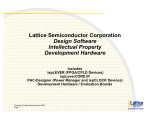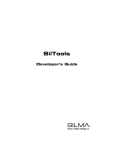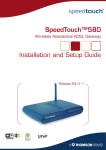Download LatticeMico8 Development Tools User Guide
Transcript
LatticeMico8 Development
Tools User Guide
Copyright
Copyright © 2010 Lattice Semiconductor Corporation.
This document may not, in whole or part, be copied, photocopied,
reproduced, translated, or reduced to any electronic medium or machinereadable form without prior written consent from Lattice Semiconductor
Corporation.
Lattice Semiconductor Corporation
5555 NE Moore Court
Hillsboro, OR 97124
(503) 268-8000
October 2010
Trademarks
Lattice Semiconductor Corporation, L Lattice Semiconductor Corporation
(logo), L (stylized), L (design), Lattice (design), LSC, CleanClock, E2CMOS,
Extreme Performance, FlashBAK, FlexiClock, flexiFlash, flexiMAC, flexiPCS,
FreedomChip, GAL, GDX, Generic Array Logic, HDL Explorer, IPexpress,
ISP, ispATE, ispClock, ispDOWNLOAD, ispGAL, ispGDS, ispGDX, ispGDXV,
ispGDX2, ispGENERATOR, ispJTAG, ispLEVER, ispLeverCORE, ispLSI,
ispMACH, ispPAC, ispTRACY, ispTURBO, ispVIRTUAL MACHINE, ispVM,
ispXP, ispXPGA, ispXPLD, Lattice Diamond, LatticeEC, LatticeECP,
LatticeECP-DSP, LatticeECP2, LatticeECP2M, LatticeECP3, LatticeMico8,
LatticeMico32, LatticeSC, LatticeSCM, LatticeXP, LatticeXP2, MACH,
MachXO, MachXO2, MACO, ORCA, PAC, PAC-Designer, PAL, Performance
Analyst, Platform Manager, ProcessorPM, PURESPEED, Reveal, Silicon
Forest, Speedlocked, Speed Locking, SuperBIG, SuperCOOL, SuperFAST,
SuperWIDE, sysCLOCK, sysCONFIG, sysDSP, sysHSI, sysI/O, sysMEM, The
Simple Machine for Complex Design, TransFR, UltraMOS, and specific
product designations are either registered trademarks or trademarks of
Lattice Semiconductor Corporation or its subsidiaries in the United States
and/or other countries. ISP, Bringing the Best Together, and More of the Best
are service marks of Lattice Semiconductor Corporation.
Other product names used in this publication are for identification purposes
only and may be trademarks of their respective companies.
Disclaimers
NO WARRANTIES: THE INFORMATION PROVIDED IN THIS DOCUMENT
IS “AS IS” WITHOUT ANY EXPRESS OR IMPLIED WARRANTY OF ANY
KIND INCLUDING WARRANTIES OF ACCURACY, COMPLETENESS,
MERCHANTABILITY, NONINFRINGEMENT OF INTELLECTUAL
PROPERTY, OR FITNESS FOR ANY PARTICULAR PURPOSE. IN NO
EVENT WILL LATTICE SEMICONDUCTOR CORPORATION (LSC) OR ITS
SUPPLIERS BE LIABLE FOR ANY DAMAGES WHATSOEVER (WHETHER
DIRECT, INDIRECT, SPECIAL, INCIDENTAL, OR CONSEQUENTIAL,
INCLUDING, WITHOUT LIMITATION, DAMAGES FOR LOSS OF PROFITS,
BUSINESS INTERRUPTION, OR LOSS OF INFORMATION) ARISING OUT
OF THE USE OF OR INABILITY TO USE THE INFORMATION PROVIDED
IN THIS DOCUMENT, EVEN IF LSC HAS BEEN ADVISED OF THE
POSSIBILITY OF SUCH DAMAGES. BECAUSE SOME JURISDICTIONS
PROHIBIT THE EXCLUSION OR LIMITATION OF CERTAIN LIABILITY,
SOME OF THE ABOVE LIMITATIONS MAY NOT APPLY TO YOU.
LSC may make changes to these materials, specifications, or information, or
to the products described herein, at any time without notice. LSC makes no
commitment to update this documentation. LSC reserves the right to
discontinue any product or service without notice and assumes no obligation
to correct any errors contained herein or to advise any user of this document
of any correction if such be made. LSC recommends its customers obtain the
latest version of the relevant information to establish, before ordering, that the
information being relied upon is current.
LatticeMico8 Development Tools User Guide
ii
Type Conventions Used in This Document
Convention Meaning or Use
Bold
Items in the user interface that you select or click. Text that you type
into the user interface.
<Italic>
Variables in commands, code syntax, and path names.
Ctrl+L
Press the two keys at the same time.
Courier
Code examples. Messages, reports, and prompts from the software.
...
Omitted material in a line of code.
.
.
.
Omitted lines in code and report examples.
[ ]
Optional items in syntax descriptions. In bus specifications, the
brackets are required.
( )
Grouped items in syntax descriptions.
{ }
Repeatable items in syntax descriptions.
|
A choice between items in syntax descriptions.
LatticeMico8 Development Tools User Guide
iii
LatticeMico8 Development Tools User Guide
iv
LatticeMico8 Development Tools User Guide
Introduction
1
1
Toolset 1
Compiler 2
Assembler, Linker, Librarian and More
LatticeMico8 Development Tools Installation
2
3
Installing LatticeMico8 Development Tools on a Windows PC 3
Uninstalling the LatticeMico8 Development Tools on Windows 9
Installing LatticeMico8 Development Tools on Linux 9
Uninstalling the LatticeMico8 Development Tools on Linux 10
Compiling a Simple Program
10
Linking Object Code 11
Generating the .mem File
Simulation
12
Making Your Software
C Library
11
13
15
LatticeMico8 Specific Features of GNU Binutils 15
Supported Binutils Features 15
Unsupported Binutils Features 15
LatticeMico8 Specific Command Line Options 16
LatticeMico8 Specific Features of the GNU Compiler Collection
Supported GCC Features 16
Unsupported GCC Features or Limitations 16
LatticeMico8 Specific Command Line Options 17
LatticeMico8 Specific Function Attributes 17
LatticeMico8 Specific Built-in Functions 18
16
Application Binary Interface 18
Data Representation 18
Function Calling Sequence 19
Interrupts 25
Further Reading
Useful Links
27
27
Technical Support Assistance
LatticeMico8 Development Tools User Guide
28
v
LatticeMico8 Development Tools User Guide
vi
LatticeMico8
Development Tools User
Guide
Introduction
The LatticeMico8 is an 8-bit microcontroller optimized for Field Programmable
Gate Arrays (FPGAs) and Crossover Programmable Logic Device
architectures from Lattice. Combining a full 18-bit wide instruction set with 32
General Purpose registers, the LatticeMico8 is a flexible reference design
written in Verilog and VHDL suitable for a wide variety of markets, including
communications, consumer, computer, medical, industrial, and automotive.
The core consumes minimal device resources, less than 200 Look Up Tables
(LUTs) in the smallest configuration, while maintaining a broad feature set.
Lattice provides development tools, including a C language compiler, for
users of the LatticeMico8 microcontroller. This document introduces readers
to the LatticeMico8 tools and includes installation instructions, LatticeMico8
specific features of the tool chain, and details on the application binary
interface that is implemented by the LatticeMico8 port of GNU binutils and
GCC.
Toolset
The LatticeMico8 development tools consist of a LatticeMico8 port of version
4.4.3 of the GNU Compiler Collection (GCC) and version 2.18 of GNU Binary
Utilities (binutils). These tools are a collection of command line executables
hosted on a Linux/Unix or Cygwin environment. Cygwin provides a UNIX-like
terminal emulation on the Windows platform.
These development tools include:
Compiler
Assembler
Linker
Copyright © 2010 Lattice Semiconductor Corporation.
Toolset
Librarian
File converter
Other file utilities
C Library
Compiler
The compiler is the GNU Compiler Collection, or GCC version 4.4.3. The
GCC included in this port is targeted for the Lattice Mico8 processor, and it is
configured to compile C language programs. Go to http://gcc.gnu.org for more
information on the GNU Compiler Collection.
Assembler, Linker, Librarian and More
The GNU Binary Utilities is a collection of programming tools for the
manipulation of object code in various object file formats. Binutils were
created to give the GNU system the facility to compile and link programs.
Binutils included in this port is configured for the LatticeMico8 target, and
each of the programs is prefixed with the target name. So you have programs
such as:
`lm8-elf-as`
The Assembler
`lm8-elf-ld`
The Linker
`lm8-elf-ar`
Create, modify, and extract from archives (libraries).
`lm8-elf-ranlib`
Generate index to archive (library) contents.
`lm8-elf-objcopy`
Copy and translate object files.
`lm8-elf-objdump`
disassembly.
`lm8-elf-size`
`lm8-elf-nm`
List section sizes and total size.
List symbols from object files.
`lm8-elf-strings`
`lm8-elf-strip`
Display information from object files including
List printable strings from files.
Discard symbols.
`lm8-elf-readelf`
Display the contents of ELF format files.
`lm8-elf-addr2line`
Convert addresses to file and line.
See the binutils user manual for more information on what each program can
do. Information on program options specific to the Lattice Mico8 processor
appears later in this document. For more information refer to http://
www.gnu.org/software/binutils/.
LatticeMico8 Development Tools User Guide
2
LatticeMico8 Development Tools Installation
LatticeMico8 Development Tools Installation
This section describes how to install the LatticeMico8 Development Tools.
You can download the tools from the Lattice Semiconductor Web site at
http://www.latticesemi.com/mico8/
The following sections describe the installation methods.
Installing LatticeMico8 Development Tools on a
Windows PC
To install the LatticeMico8 Development Tools:
1. Go to the LatticeMico8 Web page at the following URL:
http://www.latticesemi.com/mico8/
2. Download the LatticeMico8_<version_number>.exe executable.
3. Save the executable as a file.
4. Double-click the executable file name to begin the installation.
The LatticeMico8 Development Tools Setup dialog box appears, as shown
in Figure 1.
Figure 1: LatticeMico8 Development Tools Setup Dialog Box
5. Click Next.
The Product Options dialog box appears, as shown in Figure 2 on page 4.
LatticeMico8 Development Tools User Guide
3
LatticeMico8 Development Tools Installation
Figure 2: Product Options Dialog Box
When you select the GNU-based Compiler Tools option, the LatticeMico8
Development Tools install the C compiler tool chain. It is strongly
recommended that you install Cygwin along with the GNU based compiler
tools, because the compiler tools require Cygwin in order to be functional.
This copy of Cygwin contains all the components that are required by the
tools and will not interfere with any pre-existing installation of Cygwin.
6. Click Next.
LatticeMico8 Development Tools User Guide
4
LatticeMico8 Development Tools Installation
7. Click Yes to accept the terms of the licensing agreement for LatticeMico8
Development Tools, shown in Figure 3.
Figure 3: Accepting the License for the GNU-Based Compiler Tools
The Choose Destination Location part of the LatticeMico8 Development
Tools Setup dialog box now appears, as shown in Figure 4 on page 6, so
LatticeMico8 Development Tools User Guide
5
LatticeMico8 Development Tools Installation
that you can choose the folder in which the LatticeMico8 Development
Tools will be installed. The default destination folder is C:\LatticeMico8.
Figure 4: Selecting the Destination Directory
8. To accept the default destination folder, click Next. Otherwise, click
Browse to change the drive or destination folder, click OK, and follow the
installation instructions on the screen.
LatticeMico8 Development Tools User Guide
6
LatticeMico8 Development Tools Installation
9. In the Select Program Folder part of the dialog box, shown in Figure 5,
select or type the name of the default program folder, which is the folder
that contains the Lattice Semiconductor programs that you can choose
through the Start menu. If ispLEVER is installed, the default folder is the
same as that for ispLEVER.
Figure 5: Selecting the Program Folder
10. Click Next.
LatticeMico8 Development Tools User Guide
7
LatticeMico8 Development Tools Installation
11. In the Start Copying Files part of the LatticeMico8 Development Tools
Setup dialog box, shown in Figure 6 on page 8, click Next.
Figure 6: Starting the Installation
The installation begins. When it is finished, the LatticeMico8 Development
Tools Installation Completing dialog box appears.
12. Click Finish.
13. Update the path variable to include the bin folder of the compiler tools
installation. If you installed the tools in the default destination folder, the
bin folder is at C:\LatticeMico8\gtools\bin. The Path variable can be
modified by following the procedure below.
To modify the Path variable for Windows XP:
a. Chose Start > Control Panel > System
b. Select the Advanced tab of the System Properties dialoag box, and
click Environment Variables .
c. In the Environment Variables dialog box, under System Variables,
scroll to PATH and double-click it.
d. In the Edit System Variable dialog box, modify the variable value for
PATH by adding the location of the bin folder to the value for PATH.
If you do not have the item PATH, you can click New in the
Environment Variables dialog box to add a new variable. Type PATH
in the “Variable name” box and enter the location of the class in the
“Variable value” box.
e. Close the window.
LatticeMico8 Development Tools User Guide
8
LatticeMico8 Development Tools Installation
To modify the Path variable for Windows Vista:
f.
Right-click the My Computer icon and choose Properties from the
pop-up menu.
g. Select the Advanced tab (“Advanced system settings” link in Vista)
h. In the Edit System Variable dialog box, modify the variable value for
PATH by adding the location of the bin folder to the value for PATH.
If you do not have the item PATH, you can click New in the
Environment Variables dialog box to add a new variable. Type PATH
in the “Variable name” box and enter the location of the class in the
“Variable value” box.
i.
Close the window.
This completes the devlopment tools installation.
To use the tools:
Open a Cygwin shell by double-clicking the cygwin.bat found under
[installation path]\LatticeMico8\cygwin\.
Uninstalling the LatticeMico8 Development
Tools on Windows
The LatticeMico8 development tools can be unistalled using the Add/Remove
Programs tool in the Control Panel.
Installing LatticeMico8 Development Tools on
Linux
1. Go to the LatticeMico8 Web page at the following URL:
http://www.latticesemi.com/mico8/
2. Download the LatticeMico8_lm8-i386-linux_<version_number>.rpm
3. Save the file to your home directory.
4. Open up a terminal window and run the following command:
#rpm -ivh --prefix <install path> lm8-3-i386-linux.rpm
The installation begins. When it is finished, the command prompt appears
again.
Note
GCC requires the MPFR library to be installed. This library can be
obtained as an RPM package from RedHat. Make sure that this library is
installed before using the compiler tools. Attempting to compile without
installing this library will result in an error message.
5. Set the PATH environment variable to include <install path>/gtools/bin.
This completes the Linux installation process.
LatticeMico8 Development Tools User Guide
9
Compiling a Simple Program
Uninstalling the LatticeMico8 Development
Tools on Linux
Run the following command to uninstall the LatticeMico8 Development
Tools
#rpm –e lm8
Compiling a Simple Program
After installing the development tools, as described in the previous section,
you should be ready to compile a C program. Any text editor can be used to
enter a C program. The most popular text editors include vi, ed, cat, emacs,
joe and kate. Save the following program to the file hello.c using your favorite
text editor.
int main()
{
return 0;
}
After entering the program, you can compile the program by executing the
following command:
$ lm8-elf-gcc –Wall –Os –o hello.elf hello.c
The above command will compile hello.c, produce any warnings that the
compiler deems fit (-Wall), optimize for size (-Os), and produce the output in
the file hello.elf.
The contents of the hello file can now be assembled and linked. Once the
linked object code is available, the memory file can be extracted from the
linker output file and simulated through the Lattice Mico8 instruction set
simulator or run on hardware. Figure 7 on page 11 shows the complete
development flow. See “Making Your Software” on page 13 for information
about the use of Make and makefiles.
LatticeMico8 Development Tools User Guide
10
Linking Object Code
Figure 7: LatticeMico8 Development Flow
Linking Object Code
Object files are produced by a compiler as a result of processing the C or
assembly source code file. Object files contain compact code and are often
called "binaries."
The linker (lm8-elf-ld) is used to generate an executable or library by
amalgamating parts of object files together.
Generating the .mem File
After linking your software, you can generate the .mem file to be included in
your ispLever project by running the deployment tool. The deployment tool is
a Perl script that extracts the LatticeMico8 executable program from the .ELF
file.
Use the following command:
#perl lm8-deployer.pl <elf filename>
LatticeMico8 Development Tools User Guide
11
Simulation
Simulation
The software tools for LatticeMico8 include an Instruction Set Simulator for
the microcontroller, which allows programs developed for the microcontroller
to be run and debugged on a host platform. The Simulator can also be used to
generate a disassembly listing of a LatticeMico8 program. The Simulator
takes as input the memory output file of the Assembler. It emulates the
instruction execution of the LatticeMico8 in software. Note that the Simulator
does not handle interrupts.
#isp8sim -option1 -option2 ... <prom filename>
<scratch pad filename>
Table 1: Command Line Options
Option
Comment
-p
<Program Rom Size>Default is 512 opcodes.
-ix
Program file is in hexadecimal format (default). This is the file generated
by the Assembler with the -vx options (default).
-ib
Program file is in binary format. This is the file generated by the
Assembler with the -vb option.
-t
Trace the execution of the program. The Simulator will generate a trace
as it executes each instruction. It will also print the modified value of any
register (if the instruction modifies a register value).
-d
Generate a disassembly of the program specified by the PROM file.
Example: Command Line, Compile to Simulator
sequence of commands:
Consider the following
#lm8-elf-gcc -Os -mcall-prologues -mcmodel=large -o test.elf
test.c
#perl lm8-deployer.pl test.elf
#isp8sim -p 2560 -s 16 -g 16 -ix prom_init.mem
scratchpad_init.mem > test.txtout
The options set for the program lm8-elf-gcc are only the ones specified. Of
the options set, -mcall-prologues and -mcmodel=large are Mico8
specific. As stated in other parts of this document, -mcmodel= can have the
values “small” “medium” or “large.”
“Small” will cause the compiler to use on 8-bit addressing, which limits you to
256 bytes of data.
“Medium” will cause the compiler to use 16-bit addressing, which is also the
default when unspecified.
“Large” will cause 32-bit addressing to be used. Setting this option includes
extending the stack and frame pointers to be 32 bits.
LatticeMico8 Development Tools User Guide
12
Making Your Software
By using -mcall-prologues, the code size is reduced.
If -mint8 is used, the common int data type will be 8-bits instead of the
normal 16-bits.
If -m16regs is used, only the first 16 registers (r0 to r15) will be used by the
compiler.
If -mcall-stack-size= is used, it sets the size of the call stack
implemented in the target processor from the default of 16. This will control
the depth that function calls can be made.
In the above example “-Os” was set to reduce the size of the code generated.
If “-O0” is used, there will be no compiler optimization.
Making Your Software
The complete development flow can be automated by using the “GNU make.”
The “make” is a program that is widely used to build software. “Make” reads
and executes makefiles, which are descriptions of how to build something.
Makefiles typically do things such as group files together; set lists of compiler
and linker flags; list rules of how to compile source code to object code, how
to link object files, how to convert files from one type to another, and many
other things.
The following is an example of a simple makefile for building LatticeMico8
software:
#--------------------------------------------------------# Name of Project
#--------------------------------------------------------PROJECT_NAME = Software
PROJECT_EXE = $(PROJECT_NAME).elf
#--------------------------------------------------------# Include Source Files of Project
#--------------------------------------------------------include setup.mk
export
#--------------------------------------------------------# Define Executables to be used for various stages of
Compilation.
#--------------------------------------------------------CC = lm8-elf-gcc
LD = lm8-elf-gcc
AS = lm8-elf-as
AR = lm8-elf-ar
SZ = lm8-elf-size
#--------------------------------------------------------# LM8 Memory Mode
#--------------------------------------------------------MMODE := medium
LatticeMico8 Development Tools User Guide
13
Making Your Software
#--------------------------------------------------------# Preprocessor Flags
#--------------------------------------------------------CPPFLAGS +=
#--------------------------------------------------------# Compiler Flags
#--------------------------------------------------------CFLAGS = $(PFLAGS) -mcall-prologues -mcmodel=$(MMODE) -Os
#--------------------------------------------------------# Assembler Flags
#--------------------------------------------------------ASFLAGS = $(CFLAGS)
#--------------------------------------------------------# Linker Flags
#--------------------------------------------------------LDFLAGS = $(CFLAGS)
OBJS += $(sort $(CSRCS:.c=.o))
OBJS += $(sort $(ASRCS:.S=.o))
$(PROJECT_EXE): clean $(OBJS) $(HSRCS)
@echo
@echo building application...
$(LD) -T lm8_linker_$(MMODE).ld -o $@ $(OBJS) $(LDFLAGS)
rm -f *.o
$(SZ) $(PROJECT_EXE)
@echo
@echo generating initialization files...
perl lm8-deployer.pl ./ $(PROJECT_EXE)
@echo
@echo DONE
clean:
@echo cleaning
$(foreach object, $(OBJS), $(call fn_remove_file, $(object)))
rm -f *.o
rm -f *.elf
This makefile can be executed using the following command.
#make MMODE=medium
Figure 8 on page 15 shows the process of executing the makefile.
For more information on the make program and writing makefiles, see the
“make” user manual at the GNU Manuals Online at http://www.gnu.org/
software/make/.
LatticeMico8 Development Tools User Guide
14
C Library
Figure 8: Executing the makefile
C Library
Libgcc is the Standard C Library for the lm8-elf GCC. It contains many of the
standard C routines, and it contains many non-standard routines that are
specific and useful for the Lattice Mico8 processor.
LatticeMico8 Specific Features of GNU Binutils
The LatticeMico8 port of the GNU Binutils provides full support for the GNU
assembler, linker, and disassembler. The Lattice Mico8 port uses the ELF file
format that supports most of the features provided by the file format.
Supported Binutils Features
The following features are supported by the Lattice Mico8 binutils port:
Full support for the GNU assembler
Full support for the disassembler (objdump -d, and the rest of the options).
Support for the GNU linker
Support for most of the features provided by the ELF file format.
Unsupported Binutils Features
The following features cannot be supported by the Lattice Mico8
microprocessor:
Support for shared libraries
Support for Thread Local Storage
Position independent executables
LatticeMico8 Development Tools User Guide
15
LatticeMico8 Specific Features of the GNU Compiler Col-
LatticeMico8 Specific Command Line Options
Neither the assembler nor the disassembler support any additional command
line options. The Lattice Mico8 port of the GNU linker, however, supports the
following additional command line arguments for selecting the addressing
mode of the target configuration. The following options are mutually exclusive:
Option
Comment
-mcmodel=small
Causes 8-bit addressing to be used.
-mcmodel=medium
Causes 16-bit addressing to be used. (This is the default
in the event that no switch is provided.)
-mcmodel=large
Causes 32-bit addressing to be used.
LatticeMico8 Specific Features of the GNU Compiler
Collection
The provided port of the GNU Compiler Collection (GCC) to the Lattice Mico8
processor only supports GCC's C language frontend with most of the features
found therein.
Supported GCC Features
The provided gcc port to the LatticeMico8 microcontroller supports all the
features supported by GCC's C language frontend, as documented in “Using
the GNU Compiler Collection” except for the ones mentioned in the section
below.
Unsupported GCC Features or Limitations
The following features are not supported by the LatticeMico8 GCC port or
have limited support:
Language frontends other than C (including C++, Objective C, Objective
C++, Java, FORTRAN and Ada) are not supported.
Maximum +/– 2K relative executable program addresses for branching or
calls.
It has been observed that typically programs between 100-200 lines of C
code can compile and link within this restriction easily. Bigger programs
may generate linking errors.
No floating point support.
Limited support for nested functions.
No support for newlib. Functions such as printf(), scanf(),
memset(), memcpy(), strcpy() are not available.
Calling functions through function pointers (indirect calls) are not
supported. These are declarations of the type void (*func)().
LatticeMico8 Development Tools User Guide
16
LatticeMico8 Specific Features of the GNU Compiler Col-
Built-in functions __builtin_longjmp() and
__builtin_setjmp()are not supported.
Exceptions are not supported. These are used to implement
__attribute__((cleanup())).
DWARF2 stack unwinding is not supported
No support for trampolines. Trampolines are required to support nested
functions.
LatticeMico8 Specific Command Line Options
The following command line options are supported by the Lattice Mico8 port
of GCC in addition to all the options mentioned in “Using the GNU Compiler
Collection”.
Option
Comment
-mint8
Causes the common “int” type to be 8-bit wide instead
of the standard 16-bit width.
-mcmodel=small
Causes 8-bit addressing to be used.
-mcmodel=medium
Causes 16-bit addressing to be used (default).
-mcmodel=large
Causes 32-bit addressing to be used. Setting this option
includes extending the stack and frame pointers to be
32 bits.
-m16regs
If this option is set, only the first 16 registers (r0-r15) will
be used by the compiler.
-mcall-stack-size=
Sets the size of the call stack implemented in the target
processor.
-mcall-prologues
Don't inline the function prologue/epilogue.
LatticeMico8 Specific Function Attributes
The following function attributes are supported by the Lattice Mico8 port of
GCC in addition to all the options mentioned in “Using the GNU Compiler
Collection.”
void __IRQ (void) __attribute__ ((interrupt));
The compiler will generate code to set up an interrupt stack frame suitable for
an interrupt handler in the prologue of the function that has the attribute
“interrupt” set. The function implementing the interrupt handler must be
named __IRQ so that the interrupt handler can link correctly.
LatticeMico8 Development Tools User Guide
17
Application Binary Interface
LatticeMico8 Specific Built-in Functions
The following built-in functions are supported by the Lattice Mico8 port of
GCC in addition to all the built-in functions mentioned in “Using the GNU
Compiler Collection,” except for the built-in functions
__builtin_longjmp() and __builtin_setjmp().
Function
Comment
void_builtin_export (char
value, size_t port)
Generates an “export” or “exporti” instruction.
char __builtin_import
(size_t port)
Generates an “import” or “importi” instruction.
The result of the import instruction is the
returned value.
Note
The size of the size_t type reflects the size of pointers.
Application Binary Interface
Data Representation
Table 2: Fundamental Types
Size of in code model
TYPE
C TYPE
Integral
signed char
1
1
1
1
1
1
Integral
unsigned char
1
1
1
1
1
1
Integral
signed short
2
2
2
2
2
2
Integral
unsigned short
2
2
2
2
2
2
Integral
signed int
2
2
2
2
2
2
Integral
unsigned int
2
2
2
2
2
2
Integral
signed long
4
4
4
4
4
4
Integral
unsigned long
4
4
4
4
4
4
Integral
signed long long
4
4
4
4
4
4
Integral
unsigned long long
4
4
4
4
4
4
Pointer
any-type *
any-type (*)()
4
4
4
4
4
4
Floating-point
float
4
4
4
4
4
4
LatticeMico8 Development Tools User Guide
small
medium large
Alignment in code model
(bytes)
small
medium
large
18
Application Binary Interface
Table 2: Fundamental Types (Continued)
Size of in code model
small
medium large
Alignment in code model
(bytes)
TYPE
C TYPE
small
medium
large
Floating-point
double
4
4
4
4
4
4
Floating-point
long double
4
4
4
4
4
4
A NULL pointer of any type must be zero. All floating-point types are IEEE754 compliant.
Aggregates and Unions
Aggregates (structures and arrays) and unions assume the alignment of the
element requiring the highest alignment contained therein.
An array has the alignment of the type of its elements.
Structures and unions may be padded to meet alignment requirements.
Each element is assigned to the lowest aligned address.
Bit-Fields
Structure and union definitions can have integral elements defined by a
specified number of bits. Bit-fields follow the same alignment rules as
aggregates and unions, with the following additions:
Bit-fields are allocated from most to least significant (from left to right).
A bit-field must entirely reside in a storage unit appropriate for its declared
type.
Bit-fields may share a storage unit with other struct/union elements,
including elements that are not bit-fields. Struct elements occupy different
parts of the storage unit.
Function Calling Sequence
This section describes the standard function calling sequence, including stack
frame layout, register usage, and parameter passing. The standard calling
sequence requirements apply only to global functions; however, it is
recommended that all functions use the standard calling sequence.
Register Usage
Table 3: Small Code Model Register Usage (8-Bit Addressing)
Register
Preserved across
function calls
R31
NO
Non-preserved temporary register
R30
NO
Non-preserved temporary register
R29
NO
Non-preserved temporary register
R28
NO
Non-preserved temporary register
LatticeMico8 Development Tools User Guide
Usage
19
Application Binary Interface
Table 3: Small Code Model Register Usage (8-Bit Addressing) (Continued)
Register
Preserved across
function calls
Usage
R27
YES
Preserved temporary register
R26
YES
Preserved temporary register
R25
YES
Preserved temporary register
R24
YES
Preserved temporary register
R23
YES
Preserved temporary register
R22
YES
Preserved temporary register
R21
YES
Preserved temporary register
R20
YES
Preserved temporary register
R19
YES
Preserved temporary register
R18
YES
Preserved temporary register
R17
YES
Preserved temporary register
R16
YES
Preserved temporary register
R15
YES
Frame pointer/preserved temporary register
R14
YES
Fixed—stack pointer
R13
YES
Preserved temporary
R12
NO
Non-preserved temporary
R11
NO
Non-preserved temporary
R10
NO
Non-preserved temporary
R9
YES
Preserved temporary
R7
NO
Function argument register 7
R6
NO
Function argument register 6
R5
NO
Function argument register 5
R4
NO
Function argument register 4
R3
NO
Function argument register/return value register 3
R2
NO
Function argument register/return value register 2
R1
NO
Function argument register/return value register 1
R0
NO
Function argument register/return value register 0
Some registers have assigned roles:
R14 – The stack pointer holds the limit of the current stack frame. The stack
contents below the stack pointer are undefined. An exception to this rule is the
usage of red zone space in leaf functions. The stack pointer must be aligned
at all times.
LatticeMico8 Development Tools User Guide
20
Application Binary Interface
R0 through R7 – Function parameters use up to 8 registers.
R0 through R3 – Return value of the function. These registers are undefined
for void functions.
Table 4: Medium Code Model Register Usage (16-Bit Addressing)
Register
Preserved across function
calls
R31
NO
Non-preserved temporary register
R30
NO
Non-preserved temporary register
R29
NO
Non-preserved temporary register
R28
NO
Non-preserved temporary register
R27
YES
Preserved temporary register
R26
YES
Preserved temporary register
R25
YES
Preserved temporary register
R24
YES
Preserved temporary register
R23
YES
Preserved temporary register
R22
YES
Preserved temporary register
R21
YES
Preserved temporary register
R20
YES
Preserved temporary register
R19
YES
Preserved temporary register
R18
YES
Preserved temporary register
R17
YES
Preserved temporary register
R16
YES
Preserved temporary register
R15
NO
Non-preserved temporary register
R14
YES
Preserved temporary register
R13
NO
Fixed – page pointer
R12
NO
Non-preserved temporary register
R11
YES
Frame pointer/preserved temporary register
R10
YES
Frame pointer/preserved temporary register
R9
YES
Fixed – stack pointer
R8
YES
Fixed – stack pointer
R7
NO
Function argument register 7
R6
NO
Function argument register 6
R5
NO
Function argument register 5
R4
NO
Function argument register 4
LatticeMico8 Development Tools User Guide
Usage
21
Application Binary Interface
Table 4: Medium Code Model Register Usage (16-Bit Addressing) (Continued)
Register
Preserved across function
calls
Usage
R3
NO
Function argument/return value register 3
R2
NO
Function argument/return value register 2
R1
NO
Function argument/return value register 1
R0
NO
Function argument/return value register 0
Some registers have assigned roles:
{R8, R9} – The stack pointer holds the limit of the current stack frame. The
stack contents below the stack pointer are undefined. An exception to this rule
is the usage of red zone space in leaf functions. The stack pointer must be
aligned at all times.
R0 through R7 – Function parameters use up to 8 registers.
R0 through R3 – Return value of the function. These registers are undefined
for void functions.
Table 5: Large Code Model Register Usage (32-Bit Addressing)
Register
Preserved across function
calls
R31
YES
Frame pointer/preserved temporary register
R30
YES
Frame pointer/preserved temporary register
R29
YES
Frame pointer/preserved temporary register
R28
YES
Frame pointer/preserved temporary register
R27
YES
Fixed – stack pointer
R26
YES
Fixed – stack pointer
R25
YES
Fixed – stack pointer
R24
YES
Fixed – stack pointer
R23
YES
Preserved temporary register
R22
YES
Preserved temporary register
R21
YES
Preserved temporary register
R20
YES
Preserved temporary register
R19
YES
Preserved temporary register
R18
YES
Preserved temporary register
R17
YES
Preserved temporary register
R16
YES
Preserved temporary register
LatticeMico8 Development Tools User Guide
Usage
22
Application Binary Interface
Table 5: Large Code Model Register Usage (32-Bit Addressing) (Continued)
Register
Preserved across function
calls
Usage
R15
NO
Fixed – page pointer
R14
NO
Fixed – page pointer
R13
NO
Fixed – page pointer
R12
NO
Non-preserved temporary
R11
NO
Non-preserved temporary
R10
NO
Non-preserved temporary
R9
YES
Preserved temporary
R8
YES
Preserved temporary
R7
NO
Function argument register 7
R6
NO
Function argument register 6
R5
NO
Function argument register 5
R4
NO
Function argument register 4
R3
NO
Function argument/return value register 3
R2
NO
Function argument/return value register 2
R1
NO
Function argument/return value register 1
R0
NO
Function argument/return value register 0
Some registers have assigned roles:
{R24, R25, R26, R27} – The stack pointer holds the limit of the current stack
frame. The stack contents below the stack pointer are undefined. An
exception to this rule is the usage of red zone space in leaf functions. The
stack pointer must be aligned at all times.
R0 through R7 – Function parameters use up to 8 registers.
R0 through R3 – Return value of the function. For void functions, these
registers are undefined.
LatticeMico8 Development Tools User Guide
23
Application Binary Interface
The Stack Frame
Each function has a frame on the run-time stack in addition to registers. This
stack grows downward from high addresses. The table below shows the stack
frame organization.
Table 6: The Stack Frame
FP relative
position
SP relative
position
Contents
FP+ (M-6)
...
SP + (N + M + 4)
...
Function argument byte M
...
FP+ 0
SP + (N + 4)
Function argument byte 6
FP – 1
FP – 2
FP – 3
FP – 4
SP + (N + 3)
SP + (N + 2)
SP + (N + 1)
SP + N
Previous Fp value higher part, if saved
Previous Fp value higher part, if saved
Previous Fp value high part, if saved
Previous Fp value low part, if saved
FP – 5
...
SP + (N - 1)
...
Local variable N
...
FP – (N + 5)
SP + 0
Local variable 0
FP – N (N + 6)
...
SP - 1
...
Red zone area start
...
FP – (N + 37)
SP - 32
Red zone area end
Frame
Previous
Current
Future
The stack pointer always points to the end of the latest allocated stack frame.
The first 32 bytes below the stack frame are reserved for leaf functions that do
not need to modify the stack pointer. Interrupt handlers must guarantee that
they will not use this area.
LatticeMico8 Development Tools User Guide
24
Application Binary Interface
Parameter Passing
Functions receive their first eight argument bytes in function argument
registers R0-R7. If there are more than eight argument bytes, the remaining
argument bytes are passed on the stack. Small structure and union
arguments are passed in argument registers; other structure and union
arguments are passed as pointers.
Functions Returning Scalars or No Value
A function that returns an integral or pointer value puts its result in the
registers R0–R3. Void functions leave registers R0–R3 undefined.
Functions Returning Structures or Unions
A function that returns a small structure or union places the returned value in
registers R0-R3. Other structures and unions are returned in memory, pointed
by the "invisible" first function argument.
Interrupts
In the event of an interrupt, the stack pointer will be switched to the top of the
interrupt stack minus 32 where all the registers will be saved as shown in
Table 7, Table 8, and Table 9. The interrupt stack must be separate from the
user stack.
Nested interrupts are not supported by this ABI.
Table 7: Interrupt Stack Layout for the Small Code Model
Position
Register
Top of interrupt stack-1
R11
Top of interrupt stack-2
R10
Top of interrupt stack-3
R31
Top of interrupt stack-4
R30
Top of interrupt stack-5
R29
Top of interrupt stack-6
R28
Top of interrupt stack-7
R7
Top of interrupt stack-8
R6
Top of interrupt stack9
R5
Top of interrupt stack-10
R4
Top of interrupt stack-11
R3
Top of interrupt stack-12
R2
Top of interrupt stack-13
R1
Top of interrupt stack-14
R0
LatticeMico8 Development Tools User Guide
25
Application Binary Interface
Table 8: Interrupt Stack Layout for the Medium Code Model
Position
Register
Top of interrupt stack-1
R9
Top of interrupt stack-2
R8
Top of interrupt stack-3
R31
Top of interrupt stack-4
R30
Top of interrupt stack-5
R29
Top of interrupt stack-6
R28
Top of interrupt stack-7
R7
Top of interrupt stack-8
R6
Top of interrupt stack-9
R5
Top of interrupt stack-10
R4
Top of interrupt stack-11
R3
Top of interrupt stack-12
R2
Top of interrupt stack-13
R1
Top of interrupt stack-14
R0
Table 9: Interrupt Stack Layout for the Large Code Model
Position
Register
Top of interrupt stack-
R11
Top of interrupt stack-
R10
Top of interrupt stack-
R27
Top of interrupt stack-
R26
Top of interrupt stack-
R25
Top of interrupt stack-
R24
Top of interrupt stack-
R7
Top of interrupt stack-
R6
Top of interrupt stack-
R5
Top of interrupt stack-
R4
Top of interrupt stack-
R3
Top of interrupt stack-
R2
Top of interrupt stack-
R1
Top of interrupt stack-
R0
LatticeMico8 Development Tools User Guide
26
Further Reading
Scratchpad Memory
The first four bytes of the scratchpad memory area are reserved to set up the
interrupt stack in the event of an interrupt.
Address
Use
0–3
Reserved
4–255
Application data
Further Reading
This guide only touches on the options, attributes and functions that are
specific to the Lattice Mico8 port of GCC and GNU binutils. Both collections
support many options, attributes, and functions that are described in detail in
the following documents. The reader is advised to review them in addition to
this guide.
Using the GNU Compiler Collection by Richard M. Stallman and the GCC
Developers Community. Available online at http://gcc.gnu.org/onlinedocs/
gcc-4.4.3/gcc/
Using as. Available online at http://sourceware.org/binutils/docs-2.18/as/
index.html
Using ld. Available online at http://sourceware.org/binutils/docs-2.18/ld/
index.html
GNU Binary Utilities. Available online at http://sourceware.org/binutils/
docs-2.18/binutils/index.htm
Useful Links
Before asking for help online, try to find your answers in the followoing
documentation.
http://sourceforge.net [SourceForge]
http://www.gnu.org/ [GNU Project]
http://www.gnu.org/manual/ [GNU Manuals Online]
http://sources.redhat.com/binutils/ [GNU Binutils]
http://www.gnu.org/software/gcc/ [GNU Compiler Collection (GCC)]
http://www.gnu.org/software/gcc/onlinedocs/ [GCC Manuals Online]
http://srecord.sourceforge.net/ [SRecord]
http://www.gnu.org/software/make/ [GNU Make]
LatticeMico8 Development Tools User Guide
27
Technical Support Assistance
Technical Support Assistance
Hotline: 1-800-LATTICE (North America)
+1-503-268-8001 (Outside North America)
e-mail:[email protected]
Internet: www.latticesemi.com
LatticeMico8 Development Tools User Guide
28

















































